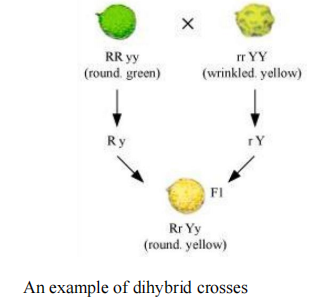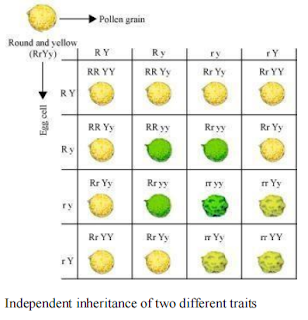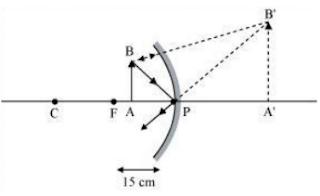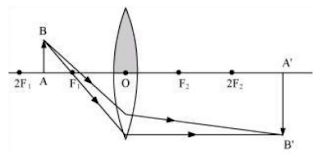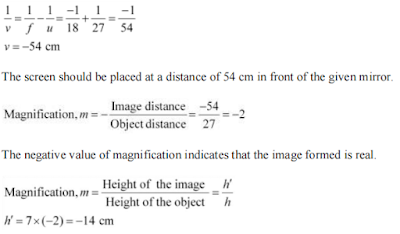CLASS 10 Science CHAPTER 9
Heredity And Evolution (NCERT Solution)
Question 1: If a trait A exists in 10% of a population of an asexually reproducing species and a trait B exists in 60% of the same population, which trait is likely to have arisen earlier?
Answer: In asexual reproduction, the reproducing cells produce a copy of their DNA through
some chemical reactions. However, this copying of DNA is not accurate and therefore, the newly
formed DNA has some variations.
It can be easily observed in the above figure that in asexual reproduction, very few variations are
allowed. Therefore, if a trait is present in only 10% of the population, it is more likely that the trait
has arisen recently. Hence, it can be concluded that trait B that exists in 60% of the same population has arisen earlier than trait A.
Question 2: How does the creation of variations in a species promote survival?
Answer: Sometimes for a species, the environmental conditions change so drastically that their
survival becomes difficult. For example, if the temperature of water increases suddenly, most of
the bacteria living in that water would die. Only few variants resistant to heat would be able to
survive. If these variants were not there, then the entire species of bacteria would have been
destroyed. Thus, these variants help in the survival of the species. However, not all variations are useful. Therefore, these are not necessarily beneficial for the individual organisms.
Question 3: How do Mendel’s experiments show that traits may be dominant or recessive?
Answer: Mendel selected true breeding tall (TT) and dwarf (tt) pea plants. Then, he crossed these
two plants. The seeds formed after fertilization were grown and these plants that were formed
represent the first filial or F1 generation. All the F1 plants obtained were tall.
Then, Mendel self-pollinated the F1 plants and observed that all plants obtained in the
F2 generation were not tall. Instead, one-fourth of the F2 plants were short.
From this experiment, Mendel concluded that the F1 tall plants were not true breeding. They were
carrying traits of both short height and tall height. They appeared tall only because the tall trait is
dominant over the dwarf trait.
Question 4: How do Mendel’s experiments show that traits are inherited independently?
Answer: Mendel crossed pea plants having round green seeds (RRyy) with pea plants having
wrinkled yellow seeds (rrYY).
.
Since the F1 plants are formed after crossing pea plants having green round seeds and pea plantshaving yellow wrinkled seeds, F1 generation will have both these characters in them. However, as
we know that yellow seed colour and round seeds are dominant characters, therefore, the F1 plants
will have yellow round seeds.
Then this F1 progeny was self-pollinated and the F2 progeny was found to have yellow round
seeds, green round seeds, yellow wrinkled seeds, and green wrinkled seeds in the ratio of 9:3:3:1.
In the above cross, more than two factors are involved, and these are independently inherited.
Question 4: A man with blood group A marries a woman with blood group O and their daughter
has blood group O. Is this information enough to tell you which of the traits − blood group A or O
− is dominant? Why or why not?
Answer: No. This information is not sufficient to determine which of the traits − blood group A
or O − is dominant. This is because we do not know about the blood group of all the progeny.
Blood group A can be genotypically AA or AO. Hence, the information is incomplete to draw any
such conclusion.
Question 5: How is the sex of the child determined in human beings?
Answer: In human beings, the females have two X chromosomes and the males have one X and
one Y chromosome. Therefore, the females are XX and the males are XY.
The gametes, as we know, receive half of the chromosomes. The male gametes have 22 autosomes
and either X or Y sex chromosome.
Type of male gametes: 22+X OR 22+ Y.
However, since the females have XX sex chromosomes, their gametes can only have X sex
chromosome.
Type of female gamete: 22+ X
Sex determination in humans
Thus, the mother provides only X chromosomes. The sex of the baby is determined by the type of
male gamete (X or Y) that fuses with the X chromosome of the female.
Question 6: What are the different ways in which individuals with a particular trait may increase
in a population?
Answer: Individuals with a particular trait may increase in a population as a result of the following:
(i) Natural selection: When that trait offers some survival advantage.
(ii) Genetic drift: When some genes governing that trait become common in a population.
(iii) When that trait gets acquired during the individual’s lifetime.
Question 7: Why are traits acquired during the life-time of an individual not inherited?
Answer: This happens because an acquired trait involves change in non-reproductive tissues
(somatic cells) which cannot be passed on to germ cells or the progeny. Therefore, these traits
cannot be inherited.
Question 8: Why are the small numbers of surviving tigers a cause of worry from the point of view of genetics?
Answer: Small numbers of tigers means that fewer variations in terms of genes are available. This means that when these tigers reproduce, there are less chances of producing progeny with some useful
variations. Hence, it is a cause of worry from the point of view of genetics.
Question 9: What factors could lead to the rise of a new species?
Answer: Natural selection, genetic drift and acquisition of traits during the life time of an
individual can give rise to new species. ill geographical isolation be a major factor in the
speciation of a self-pollinating plant species? Why or why not? Geographical isolation can prevent
the transfer of pollens among different plants. However, since the plants are self-pollinating,
which means that the pollens are transferred from the anther of one flower to the stigma of the
same flower or of another flower of the same plant, geographical isolation cannot prevent
speciation in this case.
Question 10: Will geographical isolation be a major factor in the speciation of an organism that
reproduces asexually? Why or why not?
Answer: Geographical isolation prevents gene flow between populations of a species whereas asexual reproduction generally involves only one individual. In an asexually reproducing organism, variations can occur only when the copying of DNA is not accurate. Therefore, geographical isolation cannot prevent the formation of new species in an asexually reproducing organism.
Question 11: Give an example of characteristics being used to determine how close two species are in evolutionary terms.
Answer: The presence of feathers in dinosaurs and birds indicates that they are evolutionarily related. Dinosaurs had feathers not for flying but instead these feathers provided insulation to these warm-blooded animals. However, the feathers in birds are used for flight. This proves that reptiles and birds are closely related and that the evolution of wings started in reptiles.
Question 12: Can the wing of a butterfly and the wing of a bat be considered homologous organs?
Why or why not?
Answer: The wing of a butterfly and the wing of a bat are similar in function. They help the butterfly and the bat in flying. Since they perform similar function, they are analogous organs and not homologous.
Question 13: What are fossils? What do they tell us about the process of evolution?
Answer: Fossils are the remains of organisms that once existed on earth. They represent the
ancestors of plants and animals that are alive today. They provide evidences of evolution by
revealing the characteristics of the past organism and the changes that have occurred in these
organisms to give rise to the present organisms.
Question 14: Why are human beings who look so different from each other in terms of size, colour and looks said to belong to the same species?
Answer: A species is a group of organisms that are capable of interbreeding to produce a fertile
offspring. Skin colour, looks, and size are all variety of features present in human beings. These
features are generally environmentally controlled. Various human races are formed based on these
features. However, there is no biological basis to this concept of races. Therefore, all human beings are a single species as humans of different colour, size, and looks are capable of reproduction and can produce a fertile offspring.
Question 15: In evolutionary terms, can we say which among bacteria, spiders, fish and
chimpanzees have a ‘better’ body design? Why or why not?
Answer: Evolution cannot always be equated with progress or better body designs. Evolution simply creates more complex body designs. However, this does not mean that the simple body designs are inefficient. In fact, bacteria having a simple body design are still the most cosmopolitan organisms found on earth. They can survive hot springs, deep sea, and even freezing environment. Therefore, bacteria, spiders, fish, and chimpanzees are all different branches of evolution.
Question 16: A Mendelian experiment consisted of breeding tall pea plants bearing violet flowers
with short pea plants bearing white flowers. The progeny all bore violet flowers, but almost half of them were short. This suggests that the genetic make-up of the tall parent can be depicted as
(a) TTWW
(b) TTww
(c) TtWW
(d) TtWw
Answer: (c) The genetic make-up of the tall parent can be depicted as TtWW Since all the progeny bore violet flowers, it means that the tall plant having violet flowers has WW genotype for violet flower colour. Since the progeny is both tall and short, the parent plant was not a pure tall plant. Its genotype
must be Tt. Therefore, the cross involved in the given question is
TtWw × ttww
↓
TtWw − ttww
Therefore, half the progeny is tall, but all of them have violet flowers.
Question 17: An example of homologous organs is
(a) our arm and a dog’s fore-leg.
(b) our teeth and an elephant’s tusks.
(c) potato and runners of grass.
(d) all of the above.
Answer: (b)An example of homologous organs is our teeth and an elephant’s tusks.
Question 18: In evolutionary terms, we have more in common with
(a) a Chinese school-boy.
(b) a chimpanzee.
(c) a spider.
(d) a bacterium.
Answer: (a) In evolutionary terms, we have more in common with a Chinese school boy.
Question 19: A study found that children with light- coloured eyes are likely to have parents with
light- coloured eyes. On this basis, can we say anything about whether the light eye colour trait is
dominant or recessive? Why or why not?
Answer: Let us assume that children with light- coloured eyes can either have LL or Ll or ll genotype. If the children have LL genotype, then their parents will also be of LL genotype.
LL × LL
↓
LL
If the children with light-coloured eyes have ll genotype, then their parents will also have ll
genotype.
ll×ll
↓
ll
Therefore, it cannot be concluded whether light eye colour is dominant or recessive.
Question 20: How are the areas of study − evolution and classification − interlinked?
Answer: Classification involves grouping of organism into a formal system based on similarities
in internal and external structure or evolutionary history.
Two species are more closely related if they have more characteristics in common. And if two species are more closely related, then it means they have a more recent ancestor.
For example, in a family, a brother and sister are closely related and they have a recent common
ancestor i.e., their parents. A brother and his cousin are also related but less than the sister and her
brother. This is because the brother and his cousin have a common ancestor i.e., their grandparents
in the second generation whereas the parents were from the first generation.
With subsequent generations, the variations make organisms more different than their ancestors.
Question 21: Explain the terms analogous and homologous organs with examples.
Answer: Homologous organs are similar in origin (or are embryologically similar) but perform
different functions. For example, the forelimbs of humans and the wings of birds look different
externally but their skeletal structure is similar. It means that their origin is similar (as wings in
birds are modifications of forearm) but functions are different - the wings help in flight whereas
human forearm helps in various activities.
Analogous organs, on the other hand, have different origin but perform similar functions. For example, the wings of a bird and a bat are similar in function but this similarity does not mean that these animals are more closely related. If we carefully look at these structures, then we will find that the wings of a bat are just the folds of skin that are stretched between its fingers whereas the wings of birds are present all along the arm. Therefore, these organs are analogous organs.
Question 22: Outline a project which aims to find the dominant coat colour in dogs.
Answer: Dogs have a variety of genes that govern coat colour. There are at least eleven identified
gene series (A, B, C, D, E, F, G, M, P, S, T) that influence coat colour in dog.
A dog inherits one gene from each of its parents. The dominant gene gets expressed in the
phenotype. For example, in the B series, a dog can be genetically black or brown.
Let us assume that one parent is homozygous black (BB), while the other parent is homozygous
brown (bb)
bb BB
B B
bBbBb
bBbBb
In this case, all the offsprings will be heterozygous (Bb). Since black (B) is dominant, all the offsprings will be black. However, they will have both B and b alleles.
If such heterozygous pups are crossed, they will produce 25% homozygous black (BB), 50 %
heterozygous black (Bb), and 25% homozygous brown (bb) offsprings.
B b
BBBBb
bBbBb
Question 23: Explain the importance of fossils in deciding evolutionary relationships.
Answer: Fossils are the remains of the organism that once existed on earth. They represent the
ancestors of the plants and animals that are alive today. They provide evidences of evolution by
revealing the characteristics of the past organisms and the changes that have occurred in these
organisms to give rise to the present organisms. Let us explain the importance of fossils in
deciding evolutionary history with the help of the following example.
Around 100 million years ago, some invertebrates died and were buried in the soil in that area.
More sediment accumulated on top of it turning it into sedimentary rock.
At the same place, millions of years later, some dinosaurs died and their bodies were buried on top
of the sedimentary rock. The mud containing dinosaurs also turned into a rock.
Then, millions of years later, some horse-like creatures died in that area and got fossilized in rocks
above the dinosaur fossils.
Some time later, due to soil erosion or floods in that area, the rocks containing horse-like fossils
are exposed.
If that area is excavated deeper, then the dinosaur and invertebrates fossils can also be found.
Thus, by digging that area, scientists can easily predict that horse-like animals evolved later than
the dinosaurs and the invertebrates.
Thus, the above example suggests that the fossils found closer to the surface of the earth are more
recent ones than the fossils present in deeper layers.www.ncrtsolutions.in
Question 24: What evidence do we have for the origin of life from inanimate matter?
Answer: A British scientist, J.B.S. Haldane, suggested that life originated from simple inorganic
molecules. He believed that when the earth was formed, it was a hot gaseous mass containing
elements such as nitrogen, oxygen, carbon, hydrogen, etc. These elements combined to form molecules like water (H2O), carbon dioxide (CO2), methane (CH4), ammonia (NH3), etc.
After the formation of water, slowly the earth surface cooled and the inorganic molecules interacted with one another in water to form simple organic molecules such as sugars, fatty acids, amino acids, etc. The energy for these reactions was provided by solar radiations, lightning, volcanic eruptions, etc.
This was proved by the experiment of Stanley L. Miller and Harold C. Urey in 1953. They took a mixture of water (H2O), methane (CH4), ammonia (NH3), and hydrogen gas (H2) in a chamber and sparks were passed through this mixture using two electrodes. After one week, 15 % of the carbon from methane was converted into amino acids, sugars, etc. These organic molecules are polymerized and assembled to form protein molecules that gave rise to life on earth.
Miller and Urey experiment
Question 25: Explain how sexual reproduction gives rise to more viable variations than asexual
reproduction. How does this affect the evolution of those organisms that reproduce sexually?
Answer: In sexual reproduction, two individuals having different variations combine their DNA
to give rise to a new individual. Therefore, sexual reproduction allows more variations, whereas in
asexual reproduction, chance variations can only occur when the copying of DNA is not accurate.
Additionally, asexual reproduction allows very less variations because if there are more variations,
then the resultant DNA will not be able to survive inside the inherited cellular apparatus.
However, in sexual reproduction, more variations are allowed and the resultant DNA is also able
to survive, thus making the variations viable.
Variation and Evolution: Variants help the species to survive in all the conditions. Environmental
conditions such as heat, light, pests, and food availability can change suddenly at only one place.
At that time, only those variants resistant to these conditions would be able to survive. This will
slowly lead to the evolution of a better adapted species. Thus, variation helps in the evolution of
sexually reproducing organisms.
Question 26: How is the equal genetic contribution of male and female parents ensured in the
progeny?
Answer: In human beings, every somatic cell of the body contains 23 pairs of chromosomes. Out
of these 23 pairs, the first 22 pairs are known as autosomes and the remaining one pair is known
as sex chromosomes represented as X and Y.
Females have two X chromosomes and males have one X and one Y chromosome. The gamete receives half of the chromosomes. Therefore, the male gametes have 22 autosomes and either X or Y chromosome.
The female gamete, on the other hand, has 22 autosomes and X chromosome.
During reproduction, the male and female gametes fuse and thus the progeny receives 22 autosomes and one X or Y chromosome from male parent and 22 autosomes and one X chromosome from the female parent.
Question 27: Only variations that confer an advantage to an individual organism will survive in a
population. Do you agree with this statement? Why or why not?
Answer: In species, variations that offer survival advantages are naturally selected. Individuals
adjust to their environments with the help of these selected variations and consequently these
variations are passed on to their progeny. Evolution of organisms occurs as a result of this natural
selection. However, there can be some other variations, which do not offer any survival advantage and arise only accidentally. Such variations in small populations can change the frequency of some genes
even if they are not important for survival. This accidental change in the frequency of genes in small populations is referred to as genetic drift. Thus, genetic drift provides diversity (variations) without any survival advantage.
( From www.ncrtsolutions.in )



